Merrritt Street Carhouse & Shops
The Merritt Street Carhouse was the only standard gauge carhouse in the Columbus streetcar system. All the other carhouses and most of the streetcar lines were wide-gauge. There were four standard gauge streetcar lines – East Mound Street, Camp Chase on the west side, Summit Street to the north, and Steelton to the south.The Central Market Street Railway Co. constructed the standard gauge lines to carry interurbans to central Columbus. Streetcar service was also provided on the four lines. The Central Market carbarn for interurbans and streetcars was on West Mound Street. The West Mound Street carhouse was closed after the Columbus Railway & Light Co. acquired the Central Market Street Railway Co. in 1906.
The Merritt Street Carhouse and shops were built around 1908 and only serviced standard gauge streetcars. At that time, the interurbans were all serviced outside of Columbus.
Merritt Street was the first carhouse to be retired when the last standard gauge streetcar line was eliminated in 1935.
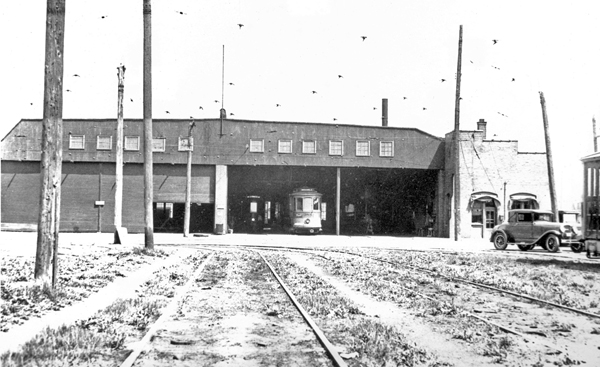
Click to enlarge
The Merritt Street carhouse and shops with the camera looking east. The left half of the building is the paint shop and car storage with space for 12 streetcars. The right half is the service area with a pit for working under the cars. The far right is the office, and behind that, the machine and carpentry shops.Unlike the other carhouses, the cars are stored outside at Merritt Street and go to the building for servicing and repairs.
The black spots in the sky are “trolley ears” used to secure the trolley wire to the overhead guy wires.
Photo from the Galen Gonser Collection, Circa 1925.
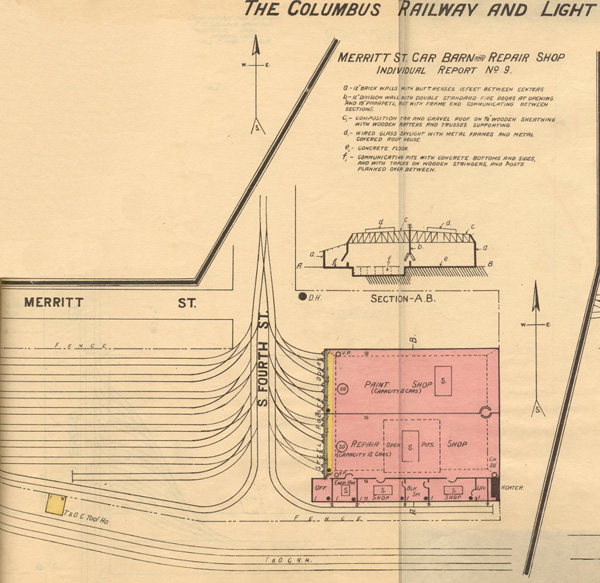
Click to enlarge
1909 Ohio Inspection Bureau Map showing the Merritt Street Carbarn and shops. The carbarn held 24 streetcars with the yard providing additional storage space.Drawing from the Edward Miller Collection.
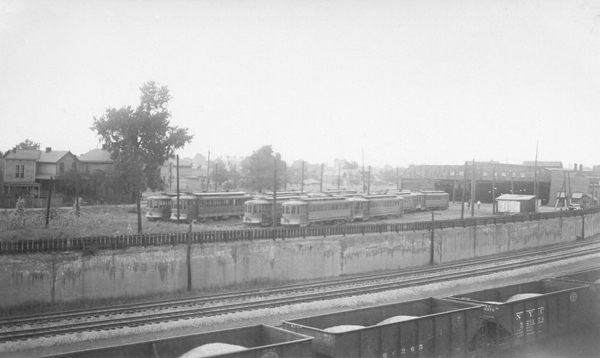
Click to enlarge
The photographer is standing on the High Street bridge looking over the New York Central (Toledo & Ohio Central) right-of-way. The NYC main line is the two tracks next to the retaining wall. There is also a four-track yard.Photo from the B.J. Kern Collection, Circa 1930.
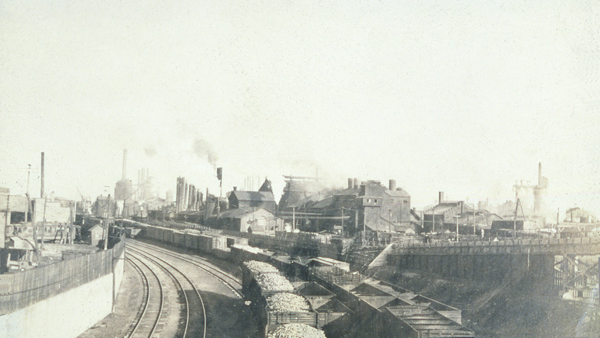
Click to enlarge
The camera is pointed toward the east, from the High Street Bridge, showing the edge of the Merritt Street complex with the NYC main line and yard in the center. Columbus’ steel mills provide the backdrop.Photo from the Columbus Metropolitan Library Collection, Circa 1925.

Click to enlarge
The photographer is in the Merritt Street yard aiming the camera to the east. Many of the closed standard gauge streetcars were rebuilt from open cars. The exposed steel plate gave the wooden underbody additional strength.Photo from the Galen Gonser Collection, Circa 1925.
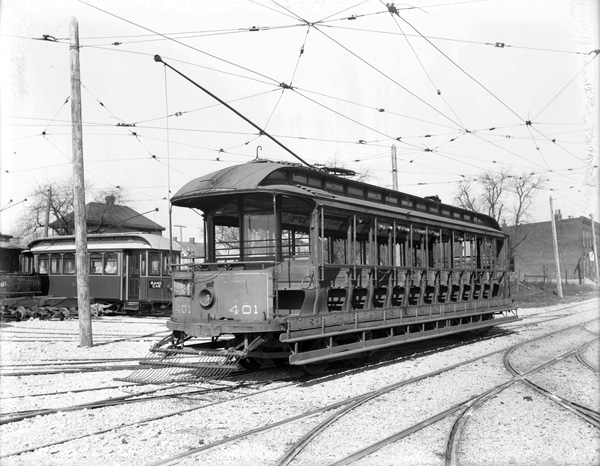
Click to enlarge
Standard gauge streetcar No. 401, built in 1902, is beat up after only 7 years service. It looks like it has spent too much time out in the elements. A four-wheel passenger car converted to work car service is in the background. The photo gives a good view of the complex overhead trolley wire.Photo from the Alex Campbell Collection, 1909.
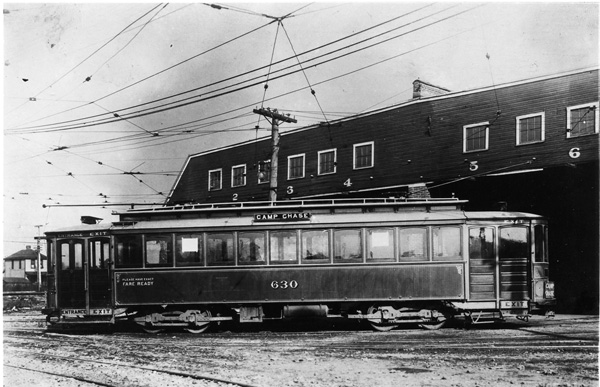
Click to enlarge
No. 630 was one of seven cars purchased in 1910 for service on the Camp Chase line. Most Columbus streetcars had Maximum-Traction trucks which had only one motor per truck. Camp Chase was located on the westside’s Hilltop area. The seven cars had two motors per truck to provide more power for the uphill grade to the Hilltop.Photo from the Alex Campbell Collection, Circa 1910.
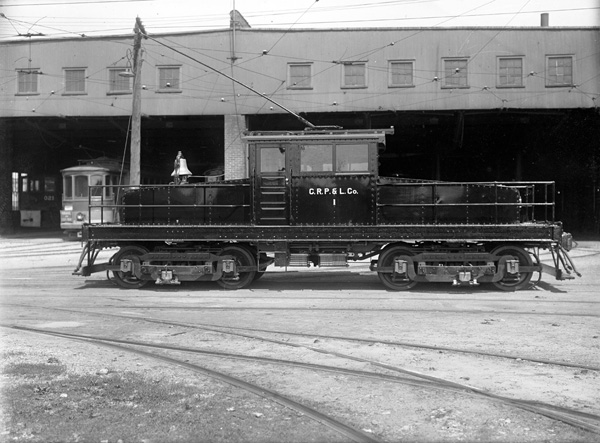
Click to enlarge
In 1925 the CRP&L Co.’s Kelton Avenue shop built two electric steeple cab locomotives for service at the Pickway Power Plant south of Columbus. No. 1 had its photo taken before traveling via the Scioto Valley Traction line to the power plant.Like all carhouses, Merritt Street had one or two snow sweepers stored away in the carhouse. Snow Sweeper No. 021 can be seen on the left.
Photo from the David Bunge Colletion Collection, 1925.

Click to enlarge
Another view of the carhouse with No. 1. ready for the trip to the Pickway Power Plant. No. 1 was built lower than most steeple cabs so it could pull ash cars from the low ceiling basement of the power plant.The electric locomotive is equipped with third rail shoes on the side of the trucks. The SVT and CRP&L yard at the power plant used third rail.
Photo from the David Bunge Colletion Collection, 1925.

Click to enlarge
The Merritt Street Carhouse and Shop employees. The largest group were the motormen and conductors in their white shirts. There are also the shopmen who maintain the cars and the cleaning crew who keep the cars presentable for the public.Photo from the Alex Campbell Collection, 1925.
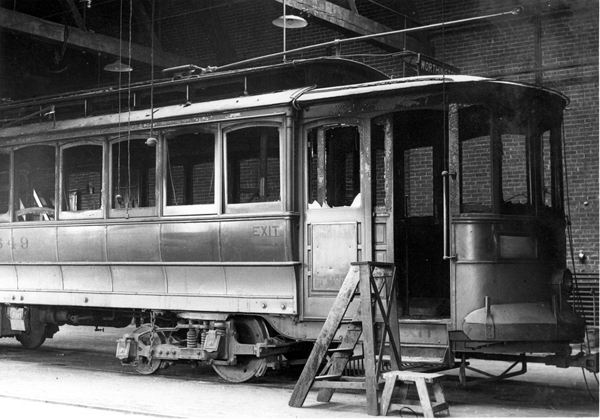
Click to enlarge
In June 1933 a Worthington streetcar caught fire at Summit Street & Fifteenth Avenue. The 600-volt trolley wire broke and touched an object at ground potential. The resultant electric arc set the streetcar on fire destroying the interior. Four firemen were injured by looking too long at the electric arc. Car No. 649 was stashed in the Merritt Street carhouse and subsequently scrapped.Photo from the David Bunge Collection, 1933.
Merritt Street Carhouse Abandon
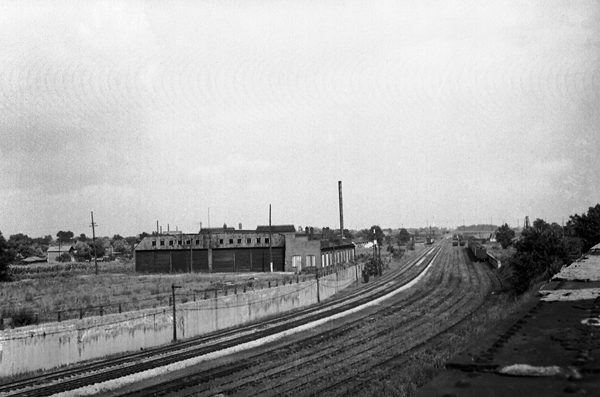
Click to enlarge
A 1939 photo of the abandoned Merritt Street carhouse take from the High Street bridge. It had been unused since 1935 when the last standard gauge line was converted to trolley buses. The NYC tracks also look unused, but not the case, as it was a busy route for coal trains headed to the Toledo docks.In 2024 the Merritt Street building still stands.
Photo from the B.J. Kern Collection, 1939.